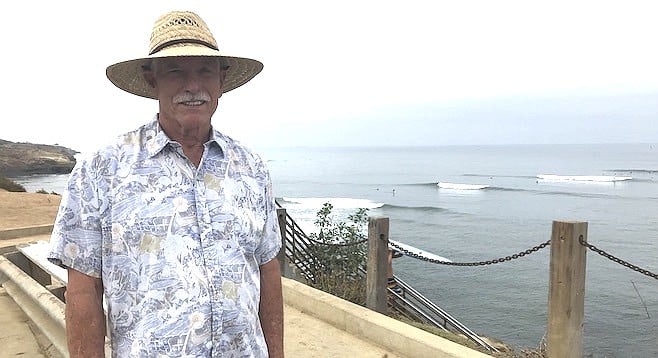 Facebook
Facebook
 X
X
 Instagram
Instagram
 TikTok
TikTok
 Youtube
Youtube

It was an overcast morning by the Sunset Cliff stairs when Michael Curtis and I started to chat. Curtis has been surfing since 1954.
“I was probably six when I started. When they came out with the movie Gidget, everyone had surf boards. You could hitchhike down to the beach and rent surf boards for 50 cents an hour, or in my case since I didn't have the 50 cents, I would walk along the beach and ask every single person who had a board if I could borrow their board. And usually I could grab one in ten to fifteen minutes.”
Curtis is a board shaper; he started in his teenage years. “I bought my first surfboard when I was 15 and it was a Dave Sweet. Then I talked my Dad into helping me and my friend make our own surfboards, but unfortunately my Dad didn’t know anything about the materials so we ended up using blocks of insulation foam and it was really weak."
"Then, in college, one of my classmates had two older brothers [named] Bill Bing and Bob Bing who made surfboards. We were able to go in and use the shaping room at the Bing factory so we started shaping and glassing boards there.”
Curtis remarked on how surfing culture has changed since the 60’s: “When I was in my teens, I thought something happened when you turned 20 and you wouldn’t be able to surf anymore because I never saw anybody over 20 surfing. Also, I never told a girl’s parents that I was a surfer because they would kick me out of the house. For them, surfing meant partying, like the Gidget movie."
“It’s been really healthy. I’ve been pre-diabetic for 40 years and I’m pretty sure surfing has helped me prevent becoming diabetic. It's still an incredible amount of fun. When I worked afternoons and evenings, I’d load up my boards every morning and I’d be driving down the road looking at everyone going to work and then I’d look at my stack of surfboards and I just couldn’t help but smile.”


It was an overcast morning by the Sunset Cliff stairs when Michael Curtis and I started to chat. Curtis has been surfing since 1954.
“I was probably six when I started. When they came out with the movie Gidget, everyone had surf boards. You could hitchhike down to the beach and rent surf boards for 50 cents an hour, or in my case since I didn't have the 50 cents, I would walk along the beach and ask every single person who had a board if I could borrow their board. And usually I could grab one in ten to fifteen minutes.”
Curtis is a board shaper; he started in his teenage years. “I bought my first surfboard when I was 15 and it was a Dave Sweet. Then I talked my Dad into helping me and my friend make our own surfboards, but unfortunately my Dad didn’t know anything about the materials so we ended up using blocks of insulation foam and it was really weak."
"Then, in college, one of my classmates had two older brothers [named] Bill Bing and Bob Bing who made surfboards. We were able to go in and use the shaping room at the Bing factory so we started shaping and glassing boards there.”
Curtis remarked on how surfing culture has changed since the 60’s: “When I was in my teens, I thought something happened when you turned 20 and you wouldn’t be able to surf anymore because I never saw anybody over 20 surfing. Also, I never told a girl’s parents that I was a surfer because they would kick me out of the house. For them, surfing meant partying, like the Gidget movie."
“It’s been really healthy. I’ve been pre-diabetic for 40 years and I’m pretty sure surfing has helped me prevent becoming diabetic. It's still an incredible amount of fun. When I worked afternoons and evenings, I’d load up my boards every morning and I’d be driving down the road looking at everyone going to work and then I’d look at my stack of surfboards and I just couldn’t help but smile.”
Comments